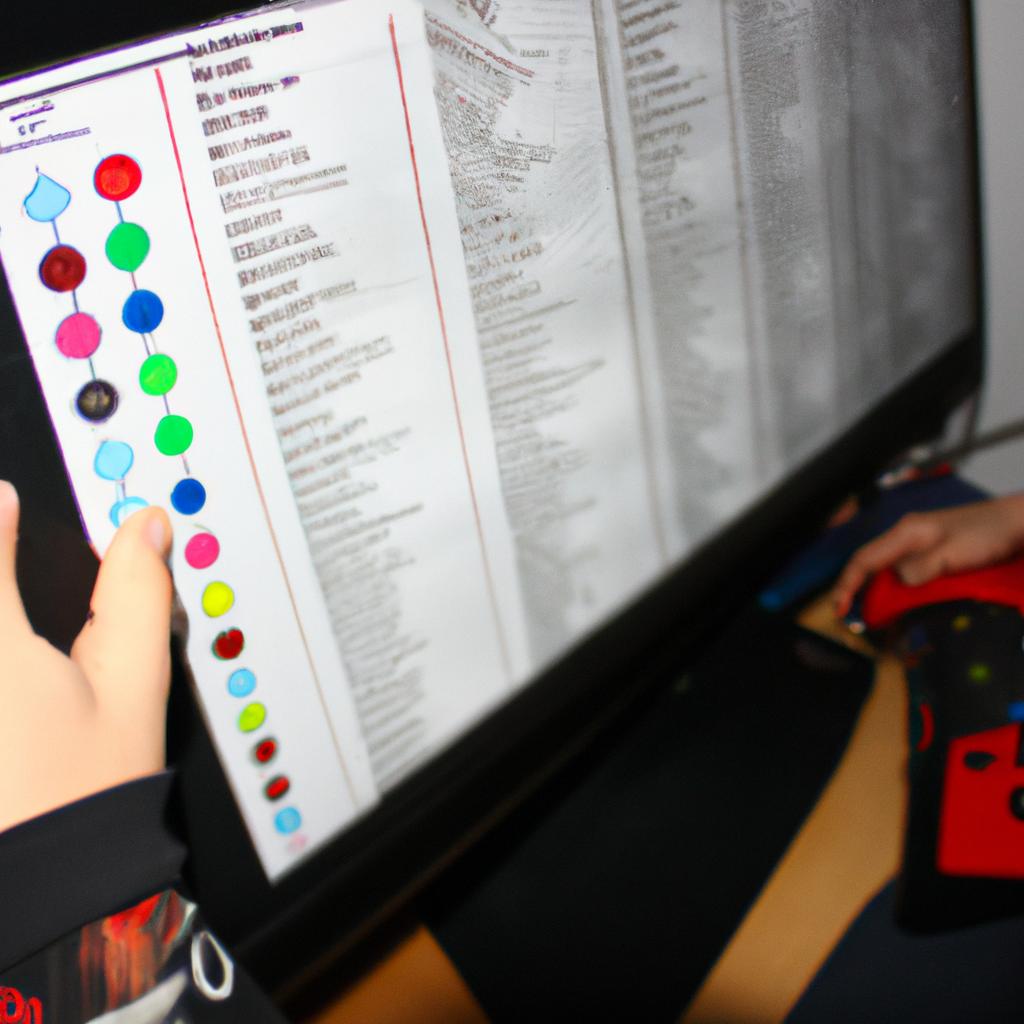A Guide to Multiplayer Game Development in the Context of Games and Video Games

In the realm of games and video games, multiplayer game development has become an increasingly prominent aspect. With the rising popularity of online gaming platforms and the desire for interactive gameplay experiences, understanding the intricacies of creating engaging multiplayer features is crucial for developers. This article serves as a comprehensive guide to navigating the complex world of multiplayer game development, providing valuable insights into the technical aspects, design considerations, and player engagement strategies.
To illustrate the significance of multiplayer game development, let us consider a hypothetical scenario where a team of indie developers is working on a new action-packed role-playing game (RPG). In this game, players are immersed in a vast virtual world filled with quests, challenges, and battles that can be completed solo or with other players from around the globe. The success of such a project relies heavily on effective multiplayer implementation that seamlessly connects individuals across various devices and locations. By dissecting this case study and examining its underlying principles, we can gain valuable knowledge applicable to broader contexts within games and video games.
Throughout this article, we will explore key concepts essential for successful multiplayer game development. From network programming techniques to server architectures and matchmaking algorithms, each topic delves deep into specific aspects required to create immersive multiplayer experiences. Additionally, discussions surrounding user experience (UX and player engagement will shed light on how to design multiplayer games that captivate and retain players.
User experience (UX) is a crucial aspect of multiplayer game development. It involves designing the gameplay, user interface, and overall interaction in a way that ensures smooth and enjoyable experiences for players. When it comes to multiplayer games, UX becomes even more critical as it directly affects player engagement and satisfaction.
To create a positive UX in multiplayer games, developers must consider factors such as network latency, responsiveness, and fairness. Network latency refers to the delay between actions performed by one player and their impact being seen or felt by other players. Minimizing latency is essential to maintain smooth gameplay and prevent frustrating experiences caused by delays.
Responsiveness is another important factor in multiplayer game UX. Players expect immediate feedback when they perform actions, such as shooting or casting spells. Developers should focus on optimizing the game’s code and networking infrastructure to ensure minimal input lag and quick response times.
Fairness is also crucial in multiplayer games. Balancing gameplay mechanics, character abilities, and matchmaking algorithms can help create a level playing field for all players involved. Unfair advantages or disadvantages can lead to frustration and negatively impact the overall experience.
In addition to UX considerations, player engagement strategies play a significant role in successful multiplayer game development. Developers need to provide incentives for players to keep coming back and engaging with the game over time.
One effective strategy is implementing progression systems that reward players for their achievements or encourage them to unlock new content. This can include leveling up characters, obtaining rare items or abilities, or unlocking new areas within the game world.
Social features are another powerful tool for player engagement in multiplayer games. Allowing players to connect with friends, form guilds or clans, participate in cooperative activities, or compete against each other creates social bonds within the gaming community. These social interactions enhance the overall experience and encourage long-term engagement.
Regular updates and new content releases also contribute to player engagement. Keeping the game fresh and introducing new challenges, quests, or events keeps players interested and motivated to continue playing.
By considering both UX principles and player engagement strategies, developers can create multiplayer games that captivate players and provide memorable experiences. Whether it’s through seamless network integration, responsive gameplay, fair competition, or engaging social features, successful multiplayer game development requires a holistic approach that prioritizes the needs and desires of the players.
In conclusion, multiplayer game development is a complex but rewarding endeavor. Understanding the technical aspects of networking, designing for optimal user experiences, and implementing effective player engagement strategies are crucial for creating immersive and successful multiplayer games. By continuously iterating on these elements and listening to player feedback, developers can craft multiplayer experiences that keep players engaged and coming back for more.
Understanding Multiplayer Mechanics
To truly grasp the intricacies of multiplayer game development, it is crucial to delve into the underlying mechanics that drive these experiences. One example that highlights the importance of understanding multiplayer mechanics is the world-renowned game Fortnite developed by Epic Games. With its massive player base and unique blend of shooter and building mechanics, Fortnite demonstrates how successful implementation of multiplayer features can elevate a game’s popularity and longevity.
When exploring multiplayer mechanics, there are several key aspects to consider. Firstly, communication plays a vital role in fostering an engaging and immersive experience for players. Establishing effective channels for real-time communication between players allows for strategizing, coordination, and social interaction within the virtual environment. Secondly, synchronization ensures that all players experience consistent gameplay across different devices and network conditions. This involves synchronizing actions such as movement, interactions, and animations to maintain fairness and prevent discrepancies among participants.
Furthermore, scalability is an essential factor when designing multiplayer games. As more players join a session or match, developers must ensure that the game infrastructure can handle increased loads without sacrificing performance or stability. Scalability also extends beyond technical considerations—it encompasses design choices that accommodate various skill levels and playstyles while maintaining balance and competitiveness.
To evoke an emotional response from aspiring game developers embarking on their multiplayer journey, here is a bullet point list showcasing some challenges they might encounter:
- Balancing player abilities to create fair competition.
- Handling unexpected network latency issues during gameplay.
- Addressing cheating concerns to maintain integrity.
- Nurturing a positive community culture by moderating toxic behavior.
In addition to understanding these challenges, it is important to be aware of common pitfalls in developing multiplayer games. The table below provides examples of potential hurdles along with suggested strategies for overcoming them:
| Challenge | Strategy |
|---|---|
| Network congestion | Implement server-side prediction techniques |
| Security vulnerabilities | Regularly update security measures |
| Server maintenance costs | Optimize server resources and explore cloud-based solutions |
| Player retention | Regularly release updates with new content and features |
Aspiring game developers can use these strategies as a foundation for building robust multiplayer experiences that captivate their audience.
Transitioning into the subsequent section about “Choosing the Right Multiplayer Framework,” it is crucial to consider various factors when selecting an appropriate framework. By carefully evaluating the specific requirements of your game, you can make an informed decision that aligns with your development goals and maximizes the potential for success.
Choosing the Right Multiplayer Framework
As we delve further into the realm of multiplayer game development, it becomes crucial to understand how to design an efficient network architecture that supports seamless gameplay experiences. To illustrate this point, let’s consider a hypothetical scenario where a team of developers is creating a massively multiplayer online role-playing game (MMORPG) called “Epic Quest.” In Epic Quest, players from all over the world can explore a vast virtual universe together, battling monsters, completing quests, and interacting with each other in real-time.
To ensure smooth and immersive gameplay in Epic Quest, it is important to consider several key factors when designing its network architecture:
-
Scalability: The network infrastructure must be able to handle a large number of concurrent players without significant performance degradation. This requires careful planning and optimization to distribute server load efficiently.
-
Latency: Minimizing latency is essential for maintaining responsive gameplay. Players should feel like they are interacting with each other in real-time rather than experiencing delays or lag. Implementing techniques such as client-side prediction and server reconciliation can help mitigate latency issues.
-
Security: As multiplayer games involve interactions between multiple users, ensuring data security is paramount. Measures such as encryption protocols and authentication mechanisms need to be implemented to protect player privacy and prevent cheating or hacking attempts.
-
Reliability: A robust network architecture should provide reliable connectivity so that players can enjoy uninterrupted gaming sessions. Redundancy measures like backup servers and failover systems can minimize downtime due to hardware failures or unexpected traffic spikes.
Consider the following table highlighting some common challenges faced during network architecture design:
| Challenge | Solution |
|---|---|
| High player concurrency | Load balancing across multiple servers |
| Network congestion | Bandwidth management and traffic prioritization |
| Packet loss | Error detection and retransmission |
| User location diversity | Content delivery networks (CDNs) |
In light of these considerations, designing a well-structured network architecture is crucial for delivering an engaging multiplayer gaming experience. The next section will explore various strategies and frameworks that can aid in this process, providing developers with the tools necessary to create connected worlds within their games.
Transitioning into the subsequent section about “Designing the Network Architecture,” we will now delve into the specific techniques and methodologies used by game developers in creating robust network infrastructures that support seamless gameplay experiences.
Designing the Network Architecture
Imagine you are developing a multiplayer game that allows players to connect and compete with each other in real-time. To ensure smooth gameplay and seamless communication between players, it is crucial to design an efficient network architecture. Let’s explore some key considerations for designing the network architecture of your multiplayer game.
One important aspect to consider when designing the network architecture is scalability. Your game should be able to handle increasing numbers of players as its popularity grows. For example, let’s say your game starts with a small player base but quickly gains traction and attracts thousands of users. Your network architecture needs to accommodate this exponential growth without compromising performance or causing server overload.
To achieve scalability, here are some essential factors to keep in mind:
- Load balancing: Implement a load balancer that distributes incoming traffic evenly across multiple servers.
- Server clustering: Use server clusters to divide the workload among different machines, allowing for better resource management and reducing latency.
- Database optimization: Employ efficient database techniques such as indexing and caching to minimize data retrieval times and improve overall responsiveness.
- Cloud infrastructure: Consider leveraging cloud-based solutions like Amazon Web Services (AWS) or Google Cloud Platform (GCP), which offer scalable resources on-demand.
In addition to scalability, security is another critical aspect of network architecture for multiplayer games. Protecting user data and preventing cheating or unauthorized access are paramount concerns. Here’s how you can enhance security within your network architecture:
| Security Measures | Description |
|---|---|
| Encryption | Encrypt all sensitive information transmitted over the network using secure protocols like SSL/TLS. |
| Authentication | Implement robust authentication mechanisms, such as username/password combinations or token-based systems, to verify the identities of connecting clients. |
| Firewall | Set up firewalls at both ends of your network connection to monitor and filter incoming/outgoing traffic based on predefined rulesets. |
| Anti-cheat systems | Employ anti-cheat measures to detect and prevent cheating within the game, ensuring fair play for all players. |
By carefully considering scalability and security in your network architecture design, you can create a solid foundation for your multiplayer game. This will not only provide an enjoyable experience for players but also instill confidence in their data privacy and integrity.
Transitioning into the next section about implementing real-time communication, let’s now delve into the technical aspects of establishing seamless player interactions through effective networking protocols and methodologies.
Implementing Real-time Communication
Continuing from the design of the network architecture, implementing real-time communication is a crucial step in multiplayer game development. By establishing a seamless connection between players and facilitating efficient data transfer, developers can create immersive and engaging gaming experiences.
To illustrate this process, let’s consider a hypothetical example of an online racing game. In this game, multiple players compete against each other in real time, requiring constant communication to ensure synchronization and accurate representation of each player’s actions. To achieve this, several key considerations must be addressed:
-
Network protocols and APIs: Selecting the appropriate network protocol and application programming interface (API) is vital for effective real-time communication. The choice depends on factors such as desired latency, bandwidth requirements, and scalability. Popular options include TCP/IP for reliable transmission or UDP for lower latency but potential packet loss.
-
Data synchronization: Synchronizing game state across all connected clients is essential to maintain fairness and consistency during gameplay. This involves exchanging information about player positions, vehicle speed, collision detection, and more. Techniques like interpolation and extrapolation are often employed to smooth out any discrepancies caused by network delays.
-
Latency compensation: Minimizing the impact of network latency ensures that players experience responsiveness when interacting with the game world. Predictive techniques like client-side prediction and server reconciliation help overcome lag issues by allowing clients to make temporary decisions while waiting for server confirmation.
-
Security measures: Safeguarding data integrity and protecting against cheating or unauthorized access is critical in multiplayer games involving live interactions among players. Encryption algorithms, authentication mechanisms, and server-side validation are commonly implemented to enhance security within the real-time communication infrastructure.
- Enhance immersion through seamless real-time interaction.
- Foster dynamic competition among players.
- Enable collaborative gameplay experiences.
- Build stronger communities through shared experiences.
| Advantages | Challenges | Recommendations |
|---|---|---|
| Real-time interaction enhances player immersion | Network latency can negatively impact gameplay experience | Implement client-side prediction techniques |
| Dynamic competition fosters engagement and excitement | Synchronizing game state across clients requires careful management | Employ interpolation methods to smooth out discrepancies |
| Collaborative gameplay encourages social connections among players | Security vulnerabilities may arise from live interactions | Utilize encryption algorithms for data protection |
As implementing real-time communication paves the way for seamless multiplayer experiences, the subsequent section will delve into handling the complexities of managing multiplayer game state. This involves synchronizing various aspects such as player positions, actions, and environment updates to ensure consistent gameplay for all participants.
Handling Multiplayer Game State
In the previous section, we explored the implementation of real-time communication in multiplayer game development. Now, let’s turn our attention to another crucial aspect: handling the multiplayer game state. To illustrate this concept, let’s consider a hypothetical scenario where players engage in an intense team-based first-person shooter game.
One key challenge in managing the game state is ensuring synchronization across all connected clients. When a player performs an action, such as firing a weapon or picking up an item, it is essential that this action is propagated accurately and promptly to all other participants. Failure to do so can lead to inconsistencies and unfair advantages within the gameplay experience.
To address this challenge effectively, developers must employ various techniques and strategies. Here are some important considerations:
- Interpolation: By utilizing interpolation algorithms, developers can smooth out discrepancies caused by network latency between different clients.
- State prediction: Implementing predictive algorithms allows for seamless gameplay by estimating future states based on past actions, reducing perceived lag.
- Server authority: Establishing server authority ensures that critical decisions regarding the game state are made centrally rather than relying solely on individual client inputs.
- Conflict resolution: Inevitably, conflicts may arise when multiple players attempt conflicting actions simultaneously. Developers need to implement robust conflict resolution mechanisms to handle these situations fairly.
To further highlight the significance of effective management of multiplayer game state, consider the following table:
| Player | Ping (ms) | Actions Per Minute (APM) |
|---|---|---|
| Player A | 50 | 150 |
| Player B | 70 | 180 |
| Player C | 100 | 120 |
| Player D | 200 | 90 |
As shown above, variations in network latency can impact each player’s ability to perform actions at their desired frequency consistently. Therefore, proper handling of the multiplayer game state becomes crucial to maintain a fair and enjoyable experience for all participants.
In summary, handling the multiplayer game state is an essential component of successful game development. By implementing techniques such as interpolation, state prediction, server authority, and conflict resolution, developers can ensure a smooth and consistent gameplay experience.
Transitioning smoothly into the subsequent section on “Testing and Debugging Multiplayer Games,” it is vital to verify that these implemented strategies effectively address potential issues within the multiplayer game environment.
Testing and Debugging Multiplayer Games
Having discussed the importance of handling multiplayer game state, we now turn our attention to testing and debugging multiplayer games. Ensuring that a multiplayer game runs smoothly and without issues is crucial for delivering an enjoyable gaming experience to players. In this section, we will explore various techniques and strategies for effectively testing and debugging multiplayer games.
Testing and Debugging Multiplayer Games
To illustrate the significance of thorough testing and meticulous debugging in multiplayer game development, let’s consider a hypothetical scenario. Imagine a team of developers working on an ambitious online role-playing game (RPG) where players can form alliances, engage in intense battles, and complete quests together. During the initial stages of development, everything seems fine until they release an early version of the game for beta-testing. Players encounter frequent disconnections, unexpected behavior during combat encounters, and even instances where character progression fails to save properly. These issues quickly lead to frustration among players and tarnish the reputation of the otherwise promising RPG.
In order to avoid such pitfalls, it is essential for developers to adopt effective testing methodologies specifically tailored for multiplayer games. Here are some key considerations:
- Unit Testing: Conduct extensive unit tests on individual components of the game codebase to ensure their functionality independently.
- Integration Testing: Perform integration tests to examine how different components interact with each other within a multiplayer environment.
- Load Testing: Simulate heavy player loads by stressing servers with numerous concurrent connections to evaluate system performance under high demand.
- Compatibility Testing: Test the compatibility between different platforms (e.g., PC, consoles) as well as across different versions or updates of operating systems.
| Key Considerations for Testing Multiplayer Games |
|---|
| Unit Testing |
| Integration Testing |
| Load Testing |
| Compatibility Testing |
By adhering to these testing practices, developers can identify and rectify issues before releasing the game to a wider audience. However, even with rigorous testing, bugs can still occur in multiplayer games. Consequently, an effective debugging process becomes indispensable for resolving any unforeseen problems that arise during gameplay.
In conclusion, comprehensive testing and meticulous debugging are vital aspects of multiplayer game development. By employing various testing methodologies like unit tests, integration tests, load tests, and compatibility tests, developers can minimize the occurrence of technical issues that may hinder players’ enjoyment. Additionally, having a robust debugging process is crucial for swiftly addressing any unexpected bugs or glitches that emerge in live multiplayer environments. With careful attention to both testing and debugging phases, developers can ensure that their multiplayer games offer seamless experiences for players around the world.








